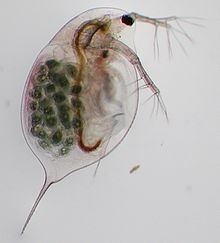Rank Species | Genus Common water fleas Order Water flea | |
 | ||
Similar Common water fleas, Water flea, Daphnia galeata, Bosmina, Bosmina longirostris | ||
Daphnia longispina water flea
Daphnia longispina is a planktonic crustacean of the genus Daphnia (Family "Daphniidae"), a cladoceran freshwater water flea. It is native to Eurasia. D. longispina is similar in size and sometimes confused with the often sympatric D. pulex (a very common species), but much smaller than D. magna. D. longispina is found in a wide range of standing freshwater bodies from small, ephemeral rock-pools to large lakes.
Contents
- Daphnia longispina water flea
- Ephippia daphnia longispina
- Life history
- Systematics and evolution
- Parasitism
- References
Ephippia daphnia longispina
Life history
Like all Daphnia species, D. longispina is a filter feeder, collecting particles of about 2 to 40 µm suspended in the water. The main food are green algae. At 20 °C maturity is reached within about 6 to 12 days, followed by a period of regular reproduction in about 3-4 day intervals. D. longispina reproduces either asexually (parthenogenesis) or sexually. For the later, females need to produce sons asexually. The same or other females can switch at any moment from asexual to sexual reproduction, but producing haploid eggs, which require fertilization by males. The sexual eggs are then deposited in an ephippium (plural: ephippia, a resting egg shell), which will sink into to the bottom of the water body when the female molts her carapace. After a resting period, which can last several years, the resting stages hatches. Only females emerge from the resting stages.
Systematics and evolution
Within the genus Daphnia, D. longispina belongs to the subgenus Hyalodaphnia, sometimes called the D.longispina complex. Closely related species of D.longispina in this complex are D. galeata and D. cucullata, with which D. longispina frequently hybridises. A revision of the species complex recently showed that the species D. rosea, D. hyalina and D. zschokkei belong to the species D. longispina, invalidating their species status.
Parasitism
In contrast to other Daphnia species, (e.g. D. magna) only few parasites have been reported to infect D. longispina. It is however frequently subject to colonization by epibionts, such as peritrich ciliates and algae
